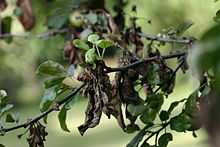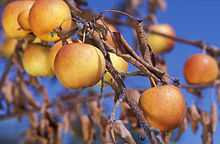Fire blight
| Erwinia amylovora | |
|---|---|
 | |
| Scientific classification | |
| Kingdom: | Eubacteria |
| Phylum: | Proteobacteria |
| Class: | Gamma Proteobacteria |
| Order: | Enterobacteriales |
| Family: | Enterobacteriaceae |
| Genus: | Erwinia |
| Species: | E. amylovora |
| Binomial name | |
| Erwinia amylovora (Burrill 1882) Winslow et al. 1920 Type strain = NCPPB 683 | |
Fire blight, also written fireblight, is a contagious disease affecting apples, pears, and some other members of the family Rosaceae. It is a serious concern to apple and pear producers. Under optimal conditions, it can destroy an entire orchard in a single growing season.
The causal pathogen is Erwinia amylovora,[1] a Gram-negative bacterium in the family Enterobacteriaceae. Pears are the most susceptible, but apples, loquat, crabapples, quinces, hawthorn, cotoneaster, pyracantha, raspberry and some other rosaceous plants are also vulnerable. The disease is believed to be indigenous to North America, from where it spread to most of the rest of the world.
Fire blight is not believed to be present in Australia though it might possibly exist there.[2] It has been a major reason for a long-standing embargo on the importation of New Zealand apples to Australia.[3] Japan was likewise believed to be without the disease, but it was discovered in pears grown in northern Japan. Japanese authorities are, however, still denying its existence, and the Japanese scientist who discovered it is believed to have committed suicide after his name was leaked to affected farmers.[4]
Symptoms
_of_pear.png)
Fireblight is a systemic disease. The term "fire blight" describes the appearance of the disease, which can make affected areas appear blackened, shrunken and cracked, as though scorched by fire.
Primary infections are established in open blossoms and tender new shoots and leaves in the spring when blossoms are open.
Dissemination

Honeybees and other insects, birds, rain and wind can transmit the bacterium to susceptible tissue. Injured tissue is also highly susceptible to infection, including punctures and tears caused by plant-sucking or biting insects. Hailstorms can infect an entire orchard in a few minutes, and growers do not wait until symptoms appear, normally beginning control measures within a few hours.
Once deposited, the bacterium enters the plant through open stomata and causes blackened, necrotic lesions, which may also produce a viscous exudate. This bacteria-laden exudate can be distributed to other parts of the same plant or to susceptible areas of different plants by rain, birds or insects, causing secondary infections. The disease spreads most quickly during hot, wet weather and is dormant in the winter when temperatures drop. Infected plant tissue contains viable bacteria, however, and will resume production of exudate upon the return of warm weather in the following spring. This exudate is then the source for new rounds of primary infections.
The pathogen spreads through the tree from the point of infection via the plant's vascular system, eventually reaching the roots and/or graft junction of the plant. Once the plant's roots are affected, the death of the plant often results. Over pruning and over fertilization (especially with nitrogen) can lead to watersprout and other midsummer growth that leave the tree more susceptible.
Treatment
Sprays of the antibiotics streptomycin or terramycin can prevent new infections. The use of such sprays has led to streptomycin-resistant bacteria in some areas, such as California and Washington. Certain biological controls consisting of beneficial bacteria or yeast can also prevent fire blight from infecting new trees. The only effective treatment for plants already infected is to prune off the affected branches and remove them from the area. Plants or trees should be inspected routinely for the appearance of new infections. The rest of the plant can be saved if the blighted wood is removed before the infection spreads to the roots.[5] There is no known cure, prevention is the key.[6]
References
- ↑ Type strain NCPPB 683
- ↑ "Australia, New Zealand trade insults over fire blight. (tree disease)". Agra Europe. May 23, 1997.
- ↑ "Local apple producers say no to Kiwis' fruit". Australian Broadcasting Corporation. Retrieved November 11, 2014.
- ↑ Helm, Leslie and Eisenstodt, Gale (July 22, 1996). "Caught in Cross-Fire of Pacific Apple War". Los Angeles Times. Retrieved August 9, 2010.
- ↑ "Fireblight: Symptoms, Causes and Treatment". University of Georgia. Retrieved November 13, 2014.
- ↑ "Fire Blight". Colorado State University. Retrieved November 13, 2014.